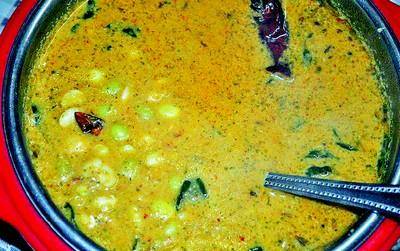Chennai :
The story goes that the original recipe for sambar – a dish which is so intrinsic to Tamil Nadu cuisine – can actually be traced to Maratha ruler Shivaji’s son.

Legend has it that Shivaji’s son Sambhaji, who was one of the Maratha rulers, attempted to make dal for himself when his head chef was away. “He added a little tamarind to the dal that he made and no one in the royal kitchen dared to correct him on the fact that tamarind was not used in dal,” says S Suresh, Tamil Nadu state convener of Intach, who gave a lecture on Tanjore Maratha history earlier this week. “He loved his own concoction, which was then referred to as sambar,” says Suresh, who adds that the other culinary contribution of the Marathas – now very popular in Tamil Nadu – is ‘poli’ (sweet roti).
Although Sambhaji’s sambhar is more lore than recipe, and there are more than 50 varieties of sambar today, chefs do admit that the Tanjore sambar is still something to be savoured. “While the Sambhaji influenced sambhar was more a tamarind soup, the Thanjavur brahmin sambar recipe is mostly followed today – where there is no onion and garlic, and the dish is not heavy on spice,” says K Natarajan, corporate chef at Gateway Hotels and Resorts.
“But even today, the sambar of Tamil Nadu is very different from what you find in the state’s neighbour Karnataka,” says Vasanthan Sigamany, associate professor of food sociology and anthropology at the Welcom Group Graduate School of Hotel Management, Manipal. “In TN, dry powders are used, while in Karnataka they use wet pastes. In Tamil Nadu, in a traditional vegetarian meal, sambar is served first and then rasam, but it is the opposite in Karnataka,” he says.
Sigamany adds that while in Tamil Nadu only local vegetables such as drumstick, radish or brinjal are used in the sambar, in other states like Kerala, ‘English’ vegetables – that became popular during the British rule in India – such as potato and carrot are used.
Over the years, sambar has seen numerous variations. Chef Damu, who specializes in Tamil Nadu cuisine, for instance, says that apart from the 30 varieties of vegetarian sambar that he prepares, he has also flirted with the idea of seafood sambar and chicken sambar, which weren’t big hits in south India. “People are still not open to the concept of chicken in their sambar. But to be honest, it is delicious,” he says.
But perhaps the most unusual of the sambars that evolved is the ‘milk sambar’, which food blogger and cooking instructor Roma Patil believes evolved in the 1930s, an unusual blend of Maratha and Jain traditions. “In Kolhapur, the Marathas ate a dish called Tambda Rassa, a kind of sambar made from lamb stock. The Rassa was so flavourful and aromatic that Jains there thought of adapting it for the Jain palate. They used milk instead of lamb stock and that was how milk sambar was made,” says Patil, who now lives in Belgaum.
source: http://www.timeofindia.indiatimes.com / The Times of India / Home> City> Chennai / by Kamini Mathai, TNN / September 26th, 2014